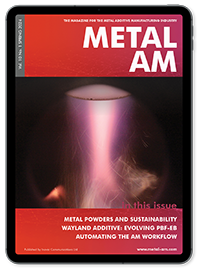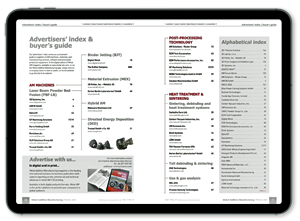Across the world, a new wave of aerospace engineers are designing and building the next generation of aero engines and systems around the revolutionary capabilities of Additive Manufacturing. Twenty years ago this was a vision, but today it is a reality. From fuel nozzles to Stage 5 and Stage 6 low pressure turbine (LPT) blades, housings to structural elements, in this article Metal AM magazine’s Technical Consultant Martin McMahon reviews the progress that has been made, shining a light on selected applications that offer insight to those in the aerospace industry who want to get up to speed with progress.
... Read more »
While the Norwegian market for Additive Manufacturing has long revolved around prototyping and polymer materials, metal Additive Manufacturing has seen rapid development in recent years. This is in large part thanks to the opportunities that the country’s oil and gas industry is now seeing in the technology. In this article, Joppe N Christensen considers why it has taken so long to get started with metal AM in Norway and introduces companies and individuals who are now leading the way.
... Read more »
General Atomics Aeronautical Systems, Inc. (GA-ASI) is the world leader in the design and manufacture of Unmanned Aircraft Systems (UAS). The company is no stranger to AM, with its Additive Design and Manufacturing Center of Excellence being integral to the qualification of more than 300 AM flight components and the installation of more than 10,000 AM parts on its aircraft. Now, it is working to identify and partner with some of the most innovative players in the industry in order to further leverage the capabilities of the technology. Divergent Technologies, the company behind Czinger Vehicles, is one such company. Jeff Kerns reports for Metal AM magazine.
... Read more »
A decade ago, the majority of commercial metal Additive Manufacturing machine, materials and application developments took place in Europe and North America. Today, the picture is very different and China in particular has become a leading global player. Clear national strategies, combined with a strong drive to leverage commercial opportunities, have resulted in a powerful and dynamic metal AM industry that is moving rapidly towards self-sufficiency. In this article, Xuesong Pan (Peter), co-founder of China’s 3D printing media company Nanjixiong, reports on recent developments.
... Read more »
Thanks to a new generation of compact metal Additive Manufacturing machines optimised for dental laboratories, combined with software improvements and optimised workflows, AM technology is now being more widely implemented in medium- to large-sized dental laboratories. In this article, Stijn Hanssen, Director, Dental Applications & Business Development, 3D Systems, reports on the application of metal AM technology for digital dentistry, reducing labour costs, maximising productivity and providing faster outcomes for patients.
... Read more »
Three years ago, Metal AM magazine published a widely read article on the use of Laser Beam Powder Bed Fusion (PBF-LB) technology for precious metal jewellery production. Today, the continuing rise of sinter-based AM technologies promises to open up the jewellery sector yet further, with new opportunities for both mass-market production as well as bespoke pieces. Chiara Armbruster, Sonja Kappler, Carlo Burkhardt, Gerald Mitteramskogler and Apollinaria Frydmann offer an overview of this new generation of solutions and the state of the technology. A number of application examples are also presented.
... Read more »
So much is discovered when it just all goes wrong. From a ‘design-fail-fix’ perspective, it’s expected that developmental components may be pushed to destruction. With rocket engines that operate near the limits of their performance, however, the need to understand the causes of a failure is critical. In the competitive commercial space business there’s a clear advantage not to disclose knowledge gained from such incidents. Thankfully, NASA can share what others cannot. Here, Alison Park, Deputy Technical Fellow, Materials and Additive Manufacturing, and Paul Gradl, Principal Engineer, share insights into one failure.
... Read more »
The importance of, and connections between, the arts and Additive Manufacturing can be unclear. For AM, the greatest challenge is managing and capitalising upon the growing awareness of its role in industry and its impact on society and daily life. Major public works, like the MX3D bridge in Amsterdam, do more to shift public perception of the possibilities AM offers, than any number of industrial successes. Elizabeth Henry, principal and founder of Henry General Strategies, explores the relationship between the world of the arts and the state of the AM industry, and ponders what benefits can be found when the two are brought together. [First published in Metal AM Vol. 8 No. 3, Autumn 2022]
... Read more »
Metal Additive Manufacturing is a foundational technology for power generation, supporting the prototyping, testing, and design of gas turbines, as well as opportunities in repair and new components. The technology’s future is also dependent on educating a new generation of engineers. Ohio State University’s Center for Design and Manufacturing Excellence (CDME), leading efforts to mature AM through the formation of an ecosystem of partners, has formed a collaboration with Siemens Energy and Engie to explore these topics and provide its students with experiential learning in metal AM. [First published in Metal AM Vol. 8 No. 3, Autumn 2022]
... Read more »
An important technology in the fight against climate change is carbon capture, able to separate CO2 from the air and convert it into useful products. To ensure that they do not add to the problem they are designed to address, carbon capture systems must operate at extreme efficiency, and require a complex system of heat exchangers, condensers, gas separators, and compressors, ideally suited to metal Additive Manufacturing. Scott Green and Dakota Black, 3D Systems, Matthew Atwood, AirCapture LLC, and Christopher L Douglas, University of Oxford, demonstrate how carbon capture efficiency can be improved through AM. [First published in Metal AM Vol. 8 No. 3, Autumn 2022]
... Read more »
For Additive Manufacturing to succeed in the volume production of components for the mainstream automotive industry, it will not only require the creation of an effective AM culture within automotive producers, but also a radical re-evaluation of what different industries need from AM machine manufacturers. Jeff Kerns visited GM’s Additive Industrialization Center (AIC), in Warren, Michigan, USA, for Metal AM magazine and spoke at length with the centre’s team about its role in the exploration of AM for automotive, and how new machine designs will increase AM’s success in the automotive industry. [First published in Metal AM Vol. 8 No. 3, Autumn 2022]
... Read more »
In 2018, a consortium of twenty-three companies, managed by DNV and Berenschot, started a project, ProGRAM JIP, to produce a guideline formulating the necessary requirements to introduce components made by Additive Manufacturing into the oil, gas and maritime industry. This was followed, in May 2020, by ProGRAM JIP Phase II, again managed by DNV and supported by Berenschot. The participants in Phase II spanned the entire value chain, from end-users and OEMs to service providers, material suppliers and testing companies. Here, DNV’s Sastry Yagnanna Kandukuri and Berenschot’s Onno Ponfoort present the consortium’s preliminary Phase II findings. [First published in Metal AM Vol. 8 No. 2, Summer 2022]
... Read more »





Join our community